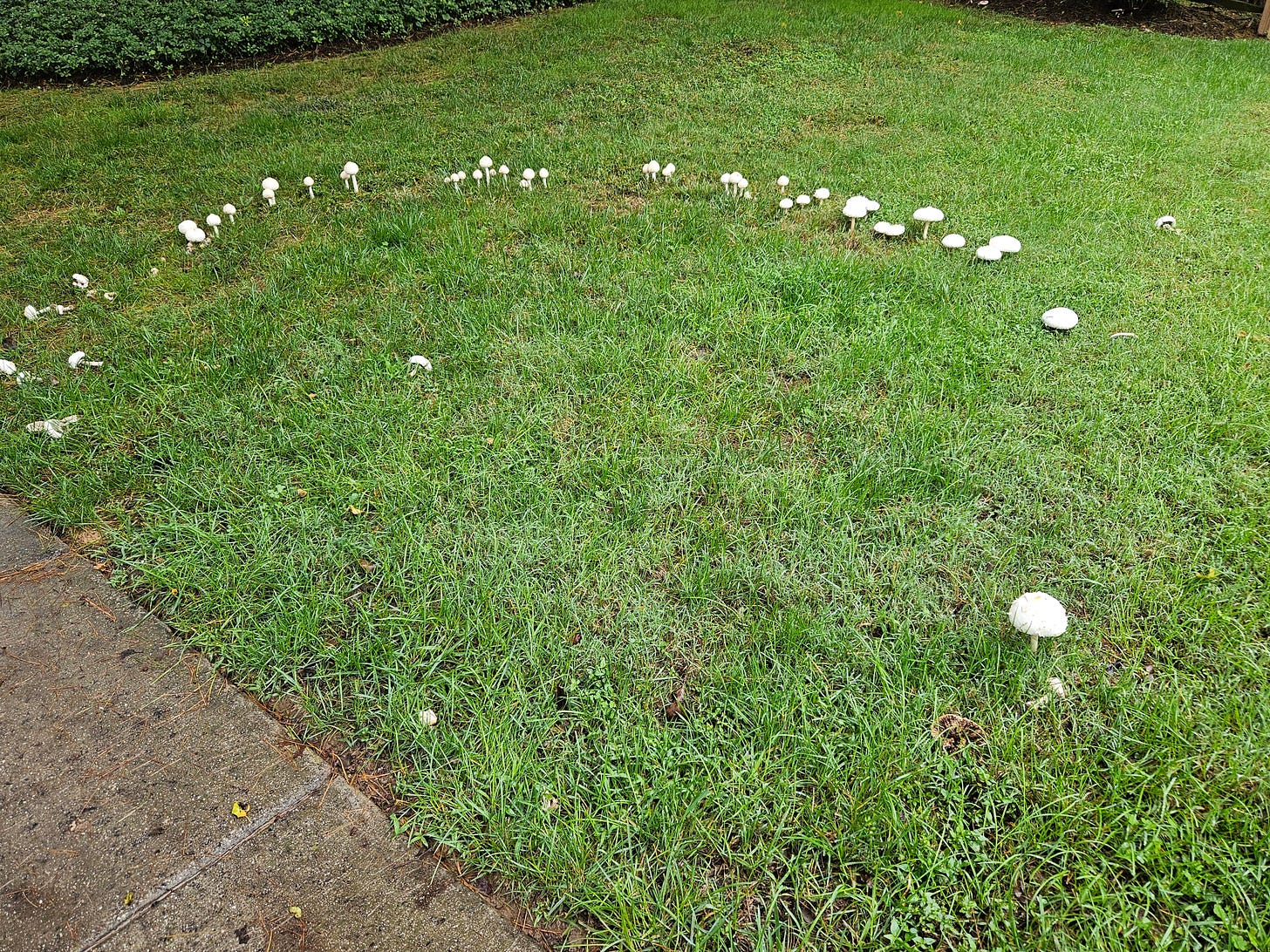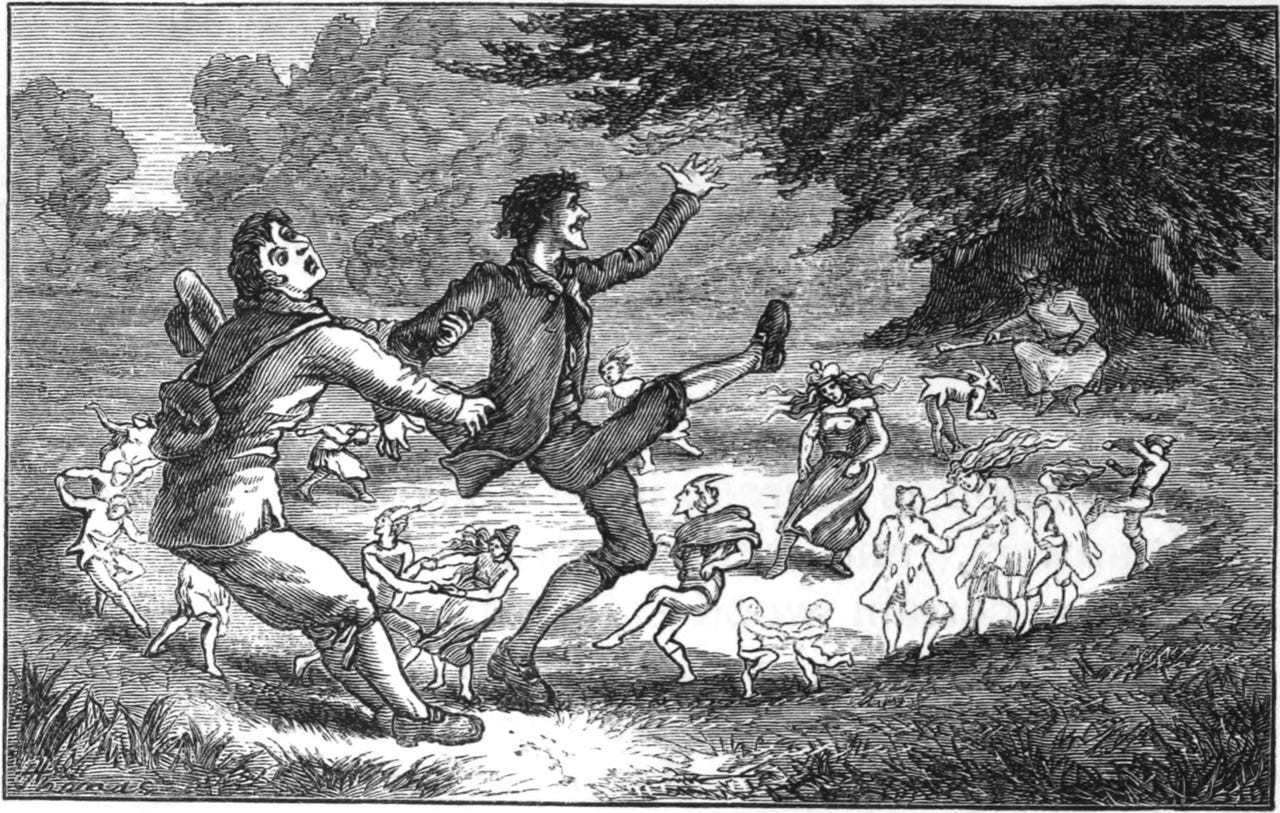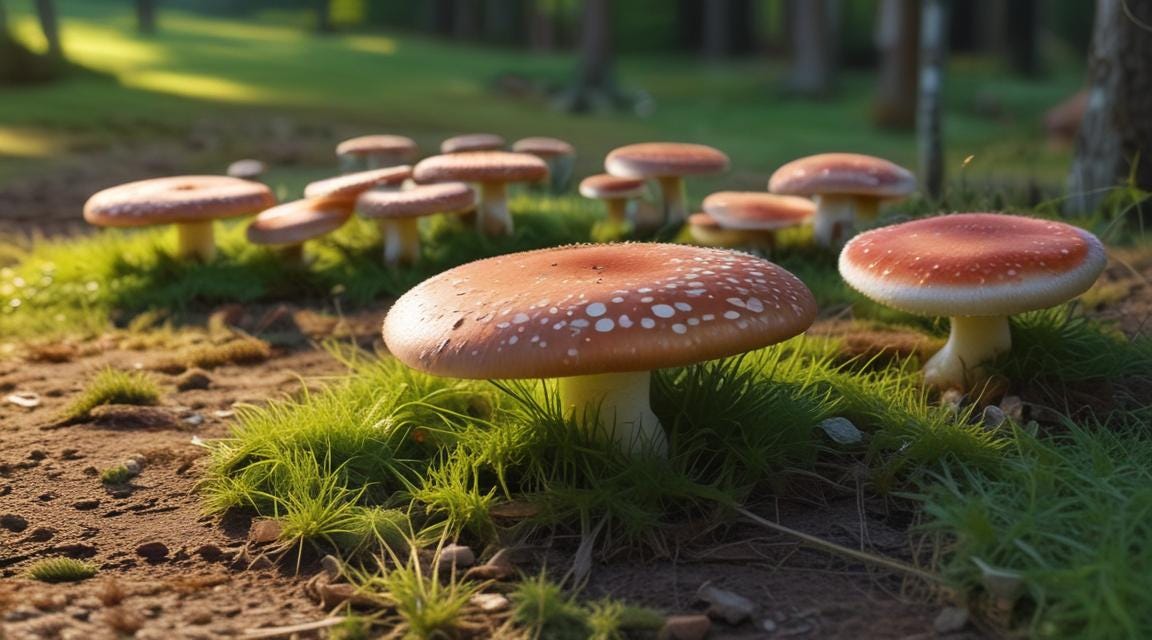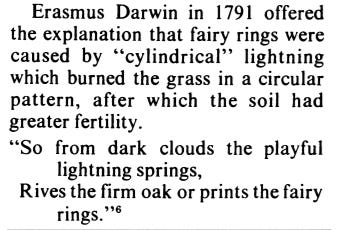It’s been a wet, muggy few weeks in my neck of the woods, and it’s only in recent days that the sun seems to have broken through the clouds.
A wet, cloudy start to fall usually isn’t something to talk about. However, the weather seems to have brought with it some friends of the fungal variety.
It seems that most people’s front yards are cropping up with mushrooms of all sizes and quantity; here’s an image from someone’s front yard of a massive green spored parasol which has an apparent sun on its cap while surrounded by drops of rain.

And when I say massive, I do mean massive- some of these caps seem to reach nearly a foot across! Well, maybe not a foot, but let’s just say that I’ve never seen mushrooms the size of these bad boys.
Unfortunately, as amazing as these green spored parasols appear, with some even bearing caps that look like toasted marshmallow, there’s nothing fun about eating this fungi.
Chlorophyllum molybdites, also known as green spored parasol and false parasol are toxic and can cause many gastrointestinal symptoms of nausea, vomiting, stomach cramps, and diarrhea. In fact, C. molybdites is one of the most frequently consumed poisonous mushrooms as it tends to be confused with other parasol mushrooms that are highly sought after as good eating.
I’m rather naïve to the world of mycology, and yet it seems like a pretty good assumption that reservations should be made against any mushrooms that wildly grow on your yard- it seems that most of the ones I and a coworker have stumbled upon and attempted to identify resulted in “possibly toxic fungus” identification.
But these massive monstrosities weren’t the strangest things out and about- see if you can notice something strange below:


The pictures aren’t too great, but if you can’t tell many of these mushrooms are weirdly oriented in a circular pattern.
I don’t think I’ve ever seen such a thing (I’ll chalk this up to being an ignorant suburbanite), but it’s hard to not notice such configurations if not for how many of them have sprinkled the local neighborhood.
Now, readers may not find this interesting, but what may interest readers is that his sort of fungal pattern has been pondered over for hundreds of years by many different people, and in fact these circular mushrooms have been a part of folklore from around the world.
That’s because these patterns have a distinction of being called fairy rings and may in some sense be considered crop circles before crop circles were a thing.
Abridged history and folklore
At least, that is how one article from 20021 describes the oddities that were these circular mushroom patterns:
Long before crop circles caught the headlines there were fairy rings. Fairy rings are, and always have been, a lot commoner than the more famous crop circles but originally their origins were just as mysterious and ascribed to some of the same causes.
Fairy rings have caught the attention of many, and because their origins were generally unknown this led many people to think of supernatural explanations for their occurrences.
The main origin of the term “fairy ring” is possibly derived from Celtic/Scandinavian folklore in which it was believed that these rings are formed after fairies and elves dance in a circular pattern, although some websites/sources suggest that the fruiting bodies were also used as resting areas for fairies after dancing.
An article from National Geographic seems to suggest that fairy rings may even date back as far as the 12th Century.

The 2002 article from Rutter seems to provide one account of a rather interesting event, and one that folklore likely drew inspiration from:
We are fortunate to have the report of John Aubrey, writing in 1663, that proves the link of fairies to fairy rings. In this he tells us the tale of his curate, Mr Hart, who was out walking over the local downs one night. As he approached a known fairy ring he was surprised to see “a quantity of pygmies, or very small people, dancing round and round, and singing and making all manner of small odd noises.” Mr Hart was unable to run away (fairy enchantment?) and eventually the little folk observed him. At this point they rushed forwards and surrounded him causing him to fall over. Once on the ground the small creatures swarmed all over him constantly pinching him and making a small quick humming noise. Eventually Mr Hart was left alone and when day broke he discovered himself to be in the middle of a fairy ring. Presumably Mr Hart was lucky not to have been abducted and returned the following day to find some 20 years had elapsed, a more common theme in fairy encounters.
Given that many tales regarding fairy rings seem to mimic that of Mr. Hart’s it wouldn’t be a surprise if this account helped to influence future stories. Of course, it could as well be that Mr. Hart’s account was inspired by tales told around that time, with his imagination running wild and playing the events out resulting in his very own tale.
Different regions also have different names for fairy rings. For instance, German folklore refers to these rings as “hexenrings” as they were suggested to be areas in which witches congregated. In Holland it’s suggested that the grass within a fairy ring would turn cow’s milk sour as this may be an area in which the devil churned butter (because the devil needs butter for some reason?). This may be related, in some part, to the compounds that are found in the soil which may influence the taste of cow’s milk.
Austrian folklore also seems to suggest that rings of dead grass may be caused by a dragon that rests in the central clearing, with its tail causing the ring of dead grass seen in some fairy circles, seeming to come from said tail circling around. A pretty interesting tale, although I find it difficult for one to find evidence of dragons sans any actual dragons…
And around the late 18th Century it was strangely proposed that fairy rings may be derived from lightning as detailed from a 1971 article3 published in the Canadian Medical Association journal:
Funnily enough, the article makes mention of a 1967 Old Farmer’s Almanac comment which alleged that a fairy ring may have been formed because of aliens:
So maybe fairy rings are more than just early crop circles…
It’s hard to find concrete details regarding some of this folklore and their regional origins, but hey, that’s what makes them folklore right?
Unfortunately, that means that many of these details cannot be corroborated aside from websites which may be citing one another as evidence of folklore.
Nonetheless, this has led to many superstitions related to fairy rings, many of which mentioning ill-fate for those who dare to literally step into the ring. Some people have suggested that those who dare trespass into fairy rings may be subjected to dance until they are driven mad or die from exhaustion. Some suggest that they are portals to a fairy realm, and thus entering into a fairy ring serves as a means of being transported.
Other consequences of entering these rings can include poor health, hallucinations, and other things that can result in life ruination. In contrast, some people have suggested that these rings may bring forth good fortune for those who live on the land, and in Britain it may be considered good luck to build a house near areas where these rings have appeared.
I guess the houses around me should appreciate their coming fortune, although I wonder if there is some superstition around incomplete fairy rings caused by sidewalks and asphalt, or how much harm running over a fairy ring with lawnmowers will cause to you…
Superstitions regarding the consequences of fairy ring intrusion seem to have lasted- you can find quite a few posts on Reddit where people talk about their experiences of entering fairy rings, such as this one from two years ago in which someone mentions seeing a figure the night after sitting in a fairy ring for five minutes.
It seems that the best course of action (at least based on the comments on Reddit, which are always trustworthy) is to show a sense of decorum towards fairy rings through asking for permission to enter, showing respect to fairy rings, and leaving gifts. One does have to wonder where these sorts of superstitions come from. After all, if any of the above tales of misfortune are true we probably wouldn’t have many people to test these methods of appeasement and live to spread the information.
Again, remember that all this information is based on what seems to be circulating online and not necessarily something documented in historical texts, so I can’t confirm many of these folklores and superstitious claims.
Fairy rings have been mentioned a few times in historical literature, with the possibly earliest instance occurring in Ben Jonson’s 1559 “humours comedy”4 play Every Man out of his Humour in which the interpretation of fairy rings seems to be more positive in nature (emphasis mine):
O heaven, that She, whose presence hath effected
This change in me, may suffer most late change
In her admired and happy government:
May still this Island be call'd Fortunate,
And rugged Treason tremble at the sound,
When Fame shall speak it with an emphasis.
Let foreign polity be dull as lead,
And pale Invasion come with half a heart,
When he but looks upon her blessed soil.
The throat of War be stopt within her land,
And turtle-footed Peace dance fairy rings
About her court; where never may there come
Suspect or danger, but all trust and safety.
Let Flattery be dumb, and Envy blind
In her dread presence; Death himself admire her;
And may her virtues make him to forget
The use of his inevitable hand.
Fly from her, Age; sleep, Time, before her throne;
Our strongest wall falls down, when she is gone.
…
The character Prospero from Shakespeare’s The Tempest5 also mentions fairy rings, albeit in reference to “elves” which could be used synonymously to fairies (emphasis mine):
You elves of hills, brooks, standing lakes, and groves,
And you that on the sands with printless foot
Do chase the ebbing Neptune, and do fly him
When he comes back; you demi-puppets that
By moonshine do the green sour ringlets make,
Whereof the ewe not bites; and you whose pastime
Is to make midnight mushrumps, that rejoice
To hear the solemn curfew; by whose aid,
Weak masters though you be, I have bedimmed
The noontide sun, called forth the mutinous winds,
And ’twixt the green sea and the azured vault…
So, we’ve covered a bit of the historical context behind fairy rings, but what exactly is their cause, and why are researchers becoming enamored by these structures?
Although not as old as the tales of fairy rings, people began to ponder the existence of fairy rings from a scientific perspective a few centuries back, with evidence from way back in 18076 of a Dr. W.H. Wollaston who hypothesized that the features of a fairy ring likely point to their formation from a centralized point:
The main hypothesis for the “ring” characteristic of fairy rings are due to the unique growth patterns of certain species of fungi, in which a fungal spore seeds a central point and radiates mycelium (the root-like structures of mushrooms) outward, forming tubular structures called hyphae. As the hyphae grows outward the central portion of the fungus dies out, resulting in the ring-like appearance.
There’s a bit more to the story, and it’s suspected that a fairy ring may be a result of more than just a central spore radiating outward, but that’s for others who are interested to learn more and do their own research.
Now, we’ve been discussing fairy rings in a rather obscure manner, but fairy rings are generally categorized into 3 different types based on the way they manifest.7

One type (listed as Type 1 above), which apparently occurs predominately on golf courses, creates the appearance of a dead ring or crescent on turf. This seems to be caused by compounds produced by the growing mycelium which create a hydrophobic environment within the soil. This results in a drought-like effect as grass cannot obtain water resulting in the grass dying and leaving a ring of decay.
One example of a fungus responsible for this type of fairy ring includes none other than the famous (and extremely expensive!) black truffle (Tuber melanosporum) which causes the appearance of a burnt circular region and is typically found associated with trees.
Another type (Type 2) does the exact opposite- a ring of enriched, dense grass may appear, which has led to many researchers to wonder what could cause this denser growth.
Blewit mushrooms (Collybia nuda, previously named Lepista nuda) are an example of this type of mushroom, although my example doesn’t appear to show this dense grass formation.
The last type (Type 3) of fairy ring is the typical fairy ring seen, with fruiting bodies appearing on the surface of a lawn. Such an event only arises when the proper environmental conditions are met, and so it’s likely that the weeks of rain and humidity helped to create a conducive environment for mushroom formation.
Green spore mushrooms (Chlorophyllum molybdites) are rather common examples of Type 3 fairy rings- again, remember that these mushrooms are toxic so don’t eat these mushrooms!
Now, in the world of modern research a lot of attention seems to have been directed at one type of fairy ring- Type 2 fairy rings, which may seem rather surprising to readers.
From fairy rings to fair chemicals
Up until recent decades it was assumed that Type 2 fairy rings were a result of saprophytic action by mycelia which resulted in organic matter digestion and nitrogen-enriched soil that helped to accelerate the growth of neighboring plants.
But a few years ago, Japanese researchers questioned whether the idea of nitrogen-rich soil was sufficient to explain the grass growth, and instead sought to see if they could isolate compounds that could be the real culprits for this phenomenon.
The result, published in a 2010 paper8, recognized one compound named 2-azahypoxanthine (AHX) as the main cause of the grass growth and was labeled by the authors as the “fairy” which causes “fairy rings”.
Prior to the 2010 paper AHX was recognized as a byproduct of the antitumor agent Dacarbazine, and AHX and was only synthetically produced, making this research the first ever natural sourcing of AHX.
This helped to kick off research into characterizing and testing these compounds which would come to be known as fairy chemicals/compounds. This would go on to include another compound isolated from blewits called imidazole-4-carboxamide (ICA) as well as a plant-derived AHX metabolite called 2-aza-8-oxohypoxanthine (AOH).
It was soon found that plants produced these compounds themselves through the purine metabolic pathway, and thus helps to explain some of the underlying mechanisms of action in plant growth. Not only did this help to show another fungus/plant relationship, but in particular it showed how fungi can produce a compound that could elicit hormonal-like alterations in plants.

Dozens of fungal species have been found to create these fairy chemicals, and researchers continue to find ways in which these compounds could be utilized, including in agriculture where these compounds may help promote growth and resilience of plants. They are also being researched as anticancer agents and are even being introduced in cosmetics as a possible antiaging agent, with the skincare product Repista being the first ever cosmetic to contain AOH which is alleged to help retain moisture, lighten skin, and reduce wrinkling (at least based on some of the information seen on some websites).
There’s still a lot that is left to be discovered, but it’s quite clear that the fairies continue to garner as much, if not more, interest than the fairy rings they produce, and many different uses of these compounds will be found in the future.
Fairy rings have enamored people for centuries, and their appearance is a reminder of a world invisible to many of us. From the superstitious belief in fairies and other supernatural entities to the unseen fungus that is buried beneath our feet, all the way to the fairy chemicals that have now caught the attention of scientists as compounds of interest, they will continue to inspire interest and curiosity.
At least, so long as we show an interest and curiosity for the world around us. As we become to tech-focused and too enclosed within four walls we lose sight of the many complexities that nature has to offer and lose sight of things that may appear trivial but would have excited prior generations.
So use this as a reminder to not take for granted the littlest things that nature has to offer- you never know what you can find!

If you enjoyed this post and other works please consider supporting me through a paid Substack subscription or through my Ko-fi. Any bit helps, and it encourages independent creators and journalists such as myself to provide work outside of the mainstream narrative.

Rutter G. (2010) Fairy Rings. Field Mycology, 3(2), 56-60.
T. H. Thomas - Google Books version of Sikes, Wirt (1880). British Goblins: Welsh Folk-lore, Fairy Mythology, Legends and Traditions pp. 74. London: Sampson Low, Marston, Searle, & Rivington.
Jackson R. (1971). Fairy rings. Canadian Medical Association journal, 105(7), 703–704.
Every Man out of his Humour seems to be the originator of humours comedy, which refers to a type of comedy in which an individual or several individuals are overcome by one particular trait which dictates much of their behaviors and personality. This phrase seems to have been derived from the four humors in ancient medicine.
The nature of this play seems to be part of an Epilogue in which a character talks highly of Queen Elizabeth, and in this context, it seems that the fairy rings mentioned are likely intended to infer good fortune to be brought upon the queen.
Excerpt is taken from Act V, Scene i.
Wollaston William Hyde 1807 VII. On Fairy-rings. Phil. Trans. R. Soc. 97 133–138
http://doi.org/10.1098/rstl.1807.0008
I am unsure if the “Types” listed are the proper order used by mycologists or just a way of distinguishing the three.
Choi, J. H., Fushimi, K., Abe, N., Tanaka, H., Maeda, S., Morita, A., Hara, M., Motohashi, R., Matsunaga, J., Eguchi, Y., Ishigaki, N., Hashizume, D., Koshino, H., & Kawagishi, H. (2010). Disclosure of the "fairy" of fairy-ring-forming fungus Lepista sordida. Chembiochem : a European journal of chemical biology, 11(10), 1373–1377. https://doi.org/10.1002/cbic.201000112
Liu S, Ye C, Guo J, Chen D-g, Liu J, Zhou X-q, et al. From fairy rings to fairy chemicals: the story from nature phenomenon to commercial application. Modern Agriculture. 2024;e24. https://doi.org/10.1002/moda.24







The variety of content you supply is excellent. I had the fortune of discovering C. Brunneum recently and was also amazed at how large these parasols can get—easily salad plate sized. Something I learned recently: if ever you discover fungus gnat larvae in your forages, some people don’t bother removing them,
and even prefer to cook them with their mushrooms since they add something crunchy and bacon-esque. The world is a marvel.
It finally rained here, after a long dry spell, so we saw all 3 types of fairy rings this week. I sorta think of them as the pasture or yard version of tinea corporis (a.k.a. ringworm).